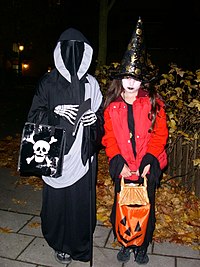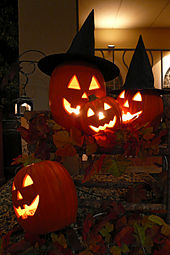Celebrating Halloween!!!
October 31, 2011
Happy Halloween!
Halloween (or Hallowe’en) is an annual holiday observed on October 31, primarily in the United States, Canada, Ireland, and the United Kingdom. It has roots in the Celtic festival of Samhain and the Christian holiday All Saints’ Day, but is today largely a secular celebration.
Common Halloween activities include trick-or-treating, wearing costumes and attending costume parties, carving jack-o’-lanterns, ghost tours, bonfires, apple bobbing, visiting haunted attractions, committing pranks, telling ghost stories or other frightening tales, and watching horror films.
History
Historian Nicholas Rogers, exploring the origins of Halloween, notes that while “some folklorists have detected its origins in the Roman feast of Pomona, the goddess of fruits and seeds, or in the festival of the dead called Parentalia, it is more typically linked to the Celtic festival of Samhain, whose original spelling was Samuin (pronounced sow-an or sow-in)”. The name is derived from Old Irish and means roughly “summer’s end”. A similar festival was held by the ancient Britons and is known as Calan Gaeaf (pronounced Kálan Gái av).
Snap-Apple Night by Daniel Maclise showing a Halloween party in Blarney, Ireland, in 1832. The young children on the right bob for apples. A couple in the center play a variant, which involves retrieving an apple hanging from a string. The couples at left play divination games.
The festival of Samhain celebrates the end of the “lighter half” of the year and beginning of the “darker half“, and is sometimesregarded as the “Celtic New Year”.
The ancient Celts believed that the border between this world and the Otherworld became thin on Samhain, allowing spirits (both harmless and harmful) to pass through. The family’s ancestors were honoured and invited home while harmful spirits were warded off. It is believed that the need to ward off harmful spirits led to the wearing of costumes and masks. Their purpose was to disguise oneself as a harmful spirit and thus avoid harm. In Scotland the spirits were impersonated by young men dressed in white with masked, veiled or blackened faces. Samhain was also a time to take stock of food supplies and slaughter livestock for winter stores.
Bonfires played a large part in the festivities. All other fires were doused and each home lit their hearth from the bonfire. The bones of slaughtered livestock were cast into its flames. Sometimes two bonfires would be built side-by-side, and people and their livestock would walk between them as a cleansing ritual. Another common practice was divination, which often involved the use of food and drink. The name ‘Halloween’ and many of its present-day traditions derive from the Old English era.
Origin of name
The word Halloween is first attested in the 16th century and represents a Scottish variant of the fuller All-Hallows-Even (“evening”), that is, the night before All Hallows Day. Up through the early 20th century, the spelling “Hallowe’en” was frequently used, eliding the “v” and shortening the word. Although the phrase All Hallows is found in Old English (ealra hālgena mæssedæg, mass-day of all saints), All-Hallows-Even is itself not attested until 1556.
Symbols
Jack-o’-lanterns in Kobe, Japan
Development of artifacts and symbols associated with Halloween formed over time encompassing customs of medieval holy days as well as contemporary cultures. The souling practice of commemorating the souls in purgatory with candle lanterns carved from turnips, became adapted into the making of jack-o’-lanterns.
In traditional Celtic Halloween festivals, large turnips were hollowed out, carved with faces, and placed in windows to ward off evil spirits. The carving of pumpkins is associated with Halloween in North America where pumpkins are both readily available and much larger – making them easier to carve than turnips. Many families that celebrate Halloween carve a pumpkin into a frightening or comical face and place it on their doorstep after dark. The American tradition of carving pumpkins preceded the Great Famine period of Irish immigration and was originally associated with harvest time in general, not becoming specifically associated with Halloween until the mid-to-late 19th century.
The imagery of Halloween is derived from many sources, including national customs, works of Gothic and horror literature (such as the novels Frankenstein and Dracula), and classic horror films (such as Frankenstein and The Mummy). Elements of the autumn season, such as pumpkins, corn husks, and scarecrows, are also prevalent. Homes are often decorated with these types of symbols around Halloween.
Halloween imagery includes themes of death, evil, the occult, magic, or mythical monsters. Traditional characters include ghosts, witches, skeletons, vampires, werewolves, demons, bats, spiders, and black cats.Black and orange are the traditional Halloween colors and represent the darkness of night and the color of bonfires, autumn leaves, and jack-o’-lanterns.
Trick-or-treating and guising

Trick-or-treating in Sweden.
Trick-or-treating is a customary celebration for children on Halloween. Children go in costume from house to house, asking for treats such as candy or sometimes money, with the question, “Trick or treat?” The word “trick” refers to a (mostly idle) “threat” to perform mischief on the homeowners or their property if no treat is given. In some parts of Scotland children still go guising. In this custom the child performs some sort of trick, i.e. sings a song or tells a ghost story, to earn their treats.
The practice of dressing up in costumes and begging door to door for treats on holidays dates back to the Middle Age and includes Christmas wassailing. Trick-or-treating resembles the late medieval practice of souling, when poor folk would go door to door on Hallowmas (November 1), receiving food in return for prayers for the dead on All Souls Day (November 2). It originated in Ireland and Britain, although similar practices for the souls of the dead were found as far south as Italy. Shakespeare mentions the practice in his comedy The Two Gentlemen of Verona (1593), when Speed accuses his master of “puling [whimpering or whining] like a beggar at Hallowmas.”The custom of wearing costumes and masks at Halloween goes back to Celtic traditions of attempting to copy the evil spirits or placate them, in Scotland for instance where the dead were impersonated by young men with masked, veiled or blackened faces, dressed in white.
American historian and author Ruth Edna Kelley of Massachusetts wrote the first book length history of the holiday in the US; The Book of Hallowe’en (1919), and references souling in the chapter “Hallowe’en in America”;
The taste in Hallowe’en festivities now is to study old traditions, and hold a Scotch party, using Burn’s poem Hallowe’en as a guide; or to go a-souling as the English used. In short, no custom that was once honored at Hallowe’en is out of fashion now.
Kelley lived in Lynn, Massachusetts, a town with 4,500 Irish immigrants, 1,900 English immigrants, and 700 Scottish immigrants in 1920. In her book, Kelley touches on customs that arrived from across the Atlantic; “Americans have fostered them, and are making this an occasion something like what it must have been in its best days overseas. All Hallowe’en customs in the United States are borrowed directly or adapted from those of other countries”.
At the time of substantial transatlantic Scottish and Irish immigration that brought the holiday to North America in the 19th century, Halloween in Scotland and Ireland had a strong tradition of “guising” — Scottish and Irish children disguised in costumes going from door to door requesting food or coins.
The earliest known reference to ritual begging on Halloween in English speaking North America occurs in 1911, when a newspaper in Kingston, Ontario reported that it was normal for the smaller children to go street “guising” (see below) on Halloween between 6 and 7 p.m., visiting shops and neighbors to be rewarded with nuts and candies for their rhymes and songs.Another isolated reference to ritual begging on Halloween appears, place unknown, in 1915, with a third reference in Chicago in 1920.
The earliest known use in print of the term “trick or treat” appears in 1927, from Blackie, Alberta, Canada:
Hallowe’en provided an opportunity for real strenuous fun. No real damage was done except to the temper of some who had to hunt for wagon wheels, gates, wagons, barrels, etc., much of which decorated the front street. The youthful tormentors were at back door and front demanding edible plunder by the word “trick or treat” to which the inmates gladly responded and sent the robbers away rejoicing.
The thousands of Halloween postcards produced between the turn of the 20th century and the 1920s commonly show children but do not depict trick-or-treating. The editor of a collection of over 3,000 vintage Halloween postcards writes, “There are cards which mention the custom [of trick-or-treating] or show children in costumes at the doors, but as far as we can tell they were printed later than the 1920s and more than likely even the 1930s. Tricksters of various sorts are shown on the early postcards, but not the means of appeasing them”. Trick-or-treating does not seem to have become a widespread practice until the 1930s, with the first U.S. appearances of the term in 1934, and the first use in a national publication occurring in 1939.
Costumes

People dressing in Halloween Costumes in Dublin.
Halloween costumes are traditionally modeled after monsters such as ghosts, skeletons, witches, and devils. Over time, the costume selection extended to include popular characters from fiction, celebrities, and generic archetypes such as ninjas and princesses.
Dressing up in costumes and going “guising” was prevalent in Scotland and Ireland at Halloween by the 19th century. Costuming became popular for Halloween parties in the US in the early 20th century, as often for adults as for children. The first mass-produced Halloween costumes appeared in stores in the 1930s when trick-or-treating was becoming popular in the United States.
What sets Halloween costumes apart from costumes for other celebrations or days of dressing up is that they are often designed to imitate supernatural and scary beings. Costumes are traditionally those of monsters such as vampires, ghosts, skeletons, witches, and devils, or in more recent years such science fiction-inspired characters as aliens and superheroes. There are also costumes of pop culture figures like presidents, athletes, celebrities, or film, television, and cartoon characters. Another popular trend is for women (and in some cases, men)to wear sexy or revealing costumes
Halloween costume parties generally fall on, or around, 31 October,
often falling on the Friday or Saturday prior to Halloween.
PUMPKIN TIME….
Video Online Only
Vegetanthony | Happy Halloween Its Pumpkin time
Happy Halloween!!!
“Happy, happy Umkin….time…..”
October 31, 2011
Tell us How You celebrate Halloween…!!!!
SHARE…Leave Comment on this Page.
Celebrating the History of Halloween …
October 31, 2011 by Team Celebration
Copyright 2022 @ A Celebration of Women™ The World Hub for Women Leaders That Care






